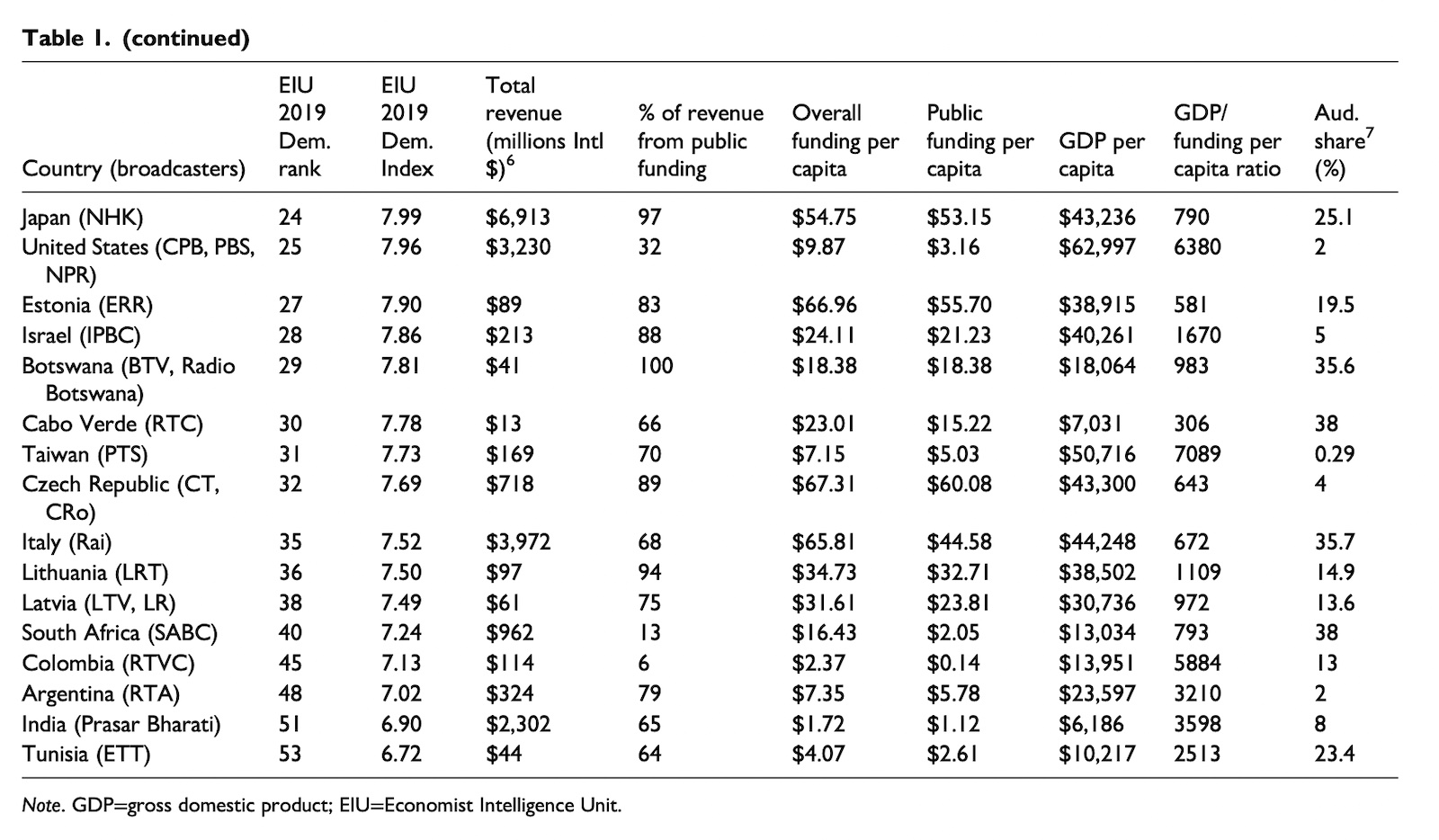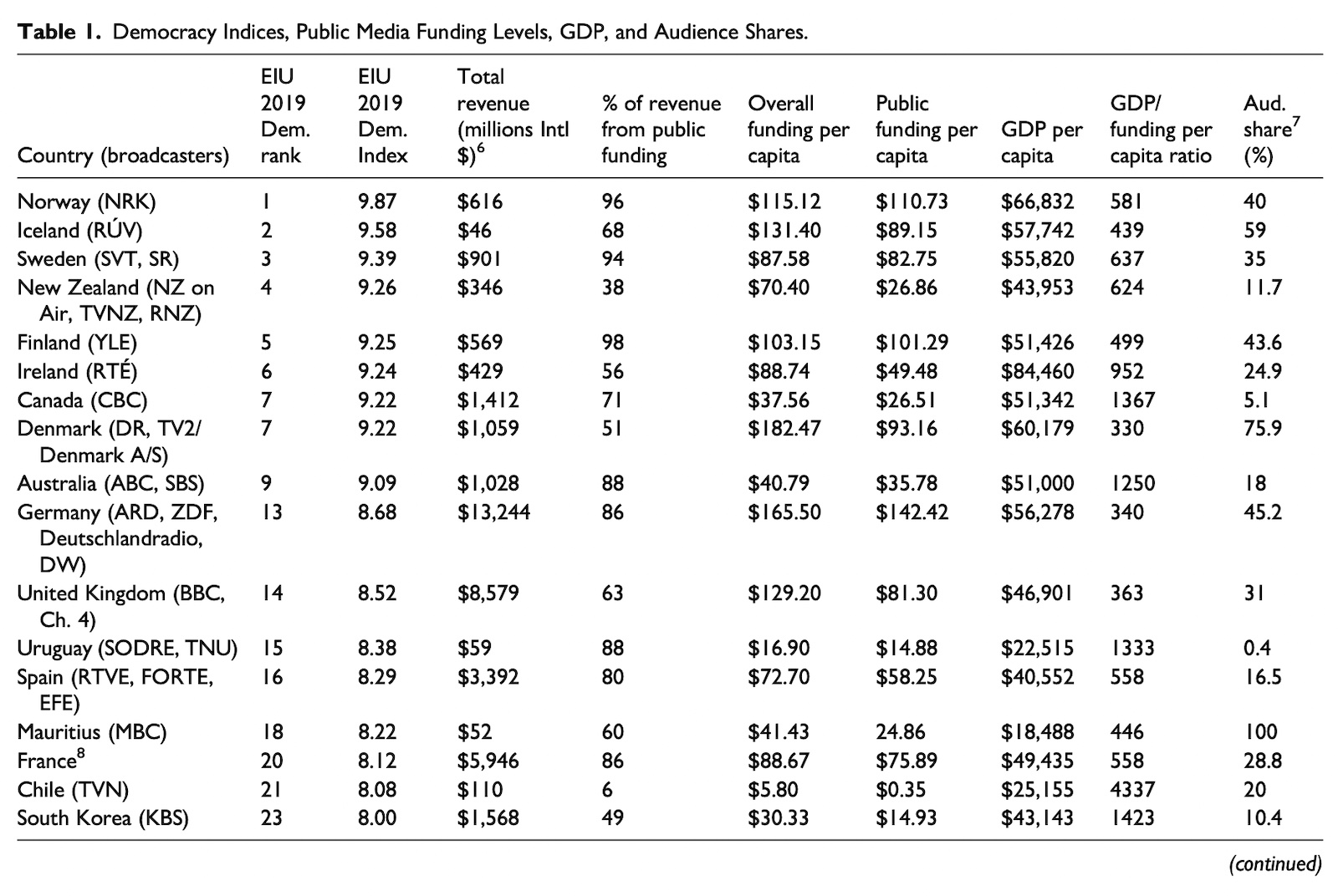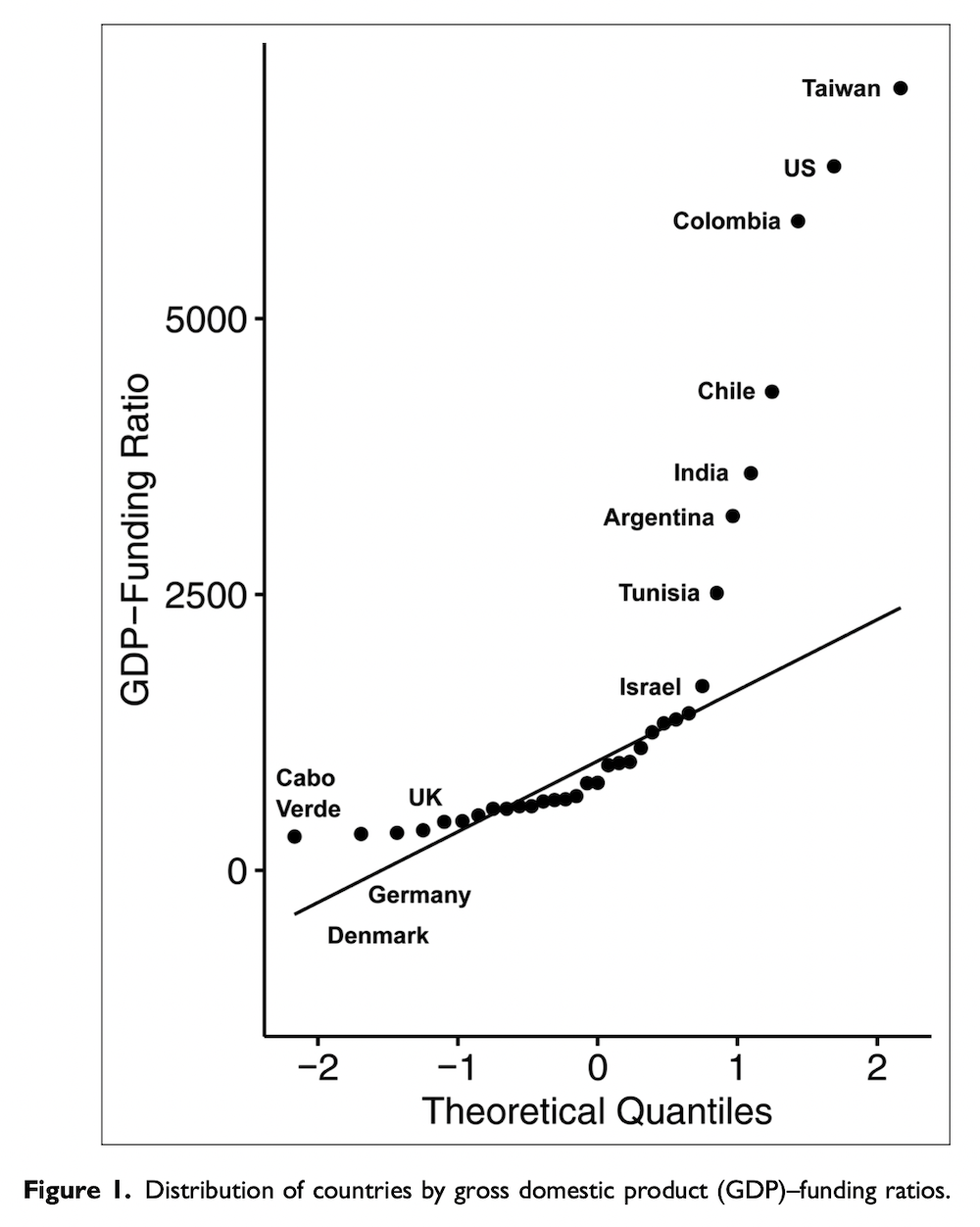
There’s a new book coming out in the U.K. this week called The BBC: A People’s History, by David Hendy. Its publisher calls it a “monumental work of popular history, making the case that the Beeb is as much of a national treasure as the NHS…a now global institution that defines Britain and created modern broadcasting.”
Cross the pond: While Americans generally like PBS and NPR, I wouldn’t expect them to come up quickly if you asked someone on the street to begin listing national treasures. (I’m even more sure America’s health care system would go unmentioned, too.) Who “created modern broadcasting” in the U.S.? It certainly wasn’t the two public broadcasters that didn’t hit airwaves until 1970. And what TV network is a “global institution” that “defines” the United States abroad? Apologies to PBS Newshour, but that’s CNN.
No one says “Auntie Peebs.”
It’s obvious that the U.S. approached the new broadcasting technologies of the 20th century in ways wildly different from their European peers — and in ways that reflect on the countries themselves. American radio began wild and unregulated, experimental, a bubbling font of creativity — and then quickly became commercialized, optimized for mass audiences and massive profits. The BBC, which turns 100 this year, was more structured, more statist, more controlled — but has remained more central to residents’ lives, more civic-minded, and more beloved.
Those different visions of public service broadcasting have affected how we get our news. But do they also affect something deeper — civic life, or democracy itself?
That’s the subject of a new paper out in The International Journal of Press/Politics. It’s titled “Funding Democracy: Public Media and Democratic Health in 33 Countries” and it’s by Timothy Neff and Victor Pickard, both of Penn. (Well, they were both of Penn; Neff just moved to the University of Leicester, crossing that pond the other way.) There’s a free copy of the paper here for the underlibraried.
The abstract:
This study examines whether and how public media systems contribute to the health of democracies in 33 countries in Europe, Africa, Asia, North America, the Middle East, Latin America, and South America.We gather national economic data and public media funding levels, audience shares, and regulatory data, primarily for 2018 and 2019 but in some cases earlier, due to lack of available data. We then assess correlations with strength of democracy indices and extend Hallin and Mancini’s typology of North American and European media systems through hierarchical cluster analysis of these 33 countries.
We find five models of public media systems around the world, ranging from “state-administered” systems with low levels of independence (Botswana and Tunisia) to systems aligning with Hallin and Mancini’s “Democratic Corporatist” model, with strong and secure (multiyear) funding, large audience shares, and strong regulatory protection for their independence. In between, we identify three mixed models: a “Liberal-Pluralist” model, a “Direct Funding” model, and a “Commercial–Public” model.
Correlations and cluster analyses show that high levels of secure funding for public media systems and strong structural protections for the political and economic independence of those systems are consistently and positively correlated with healthy democracies.
So maybe not the best sign for American democracy then.
The Hallin and Mancini referenced are Daniel C. Hallin (he of the spheres) and Paolo Mancini, authors of the media-studies classic Comparing Media Systems: Three Models of Media and Politics. They argued that the interactions between politics and media are affected not just by individual players or institutions (a Murdoch or a New York Times) but by the structures of a country’s broader media system — something influenced by government regulation, political history, technology, geography, and the market, among other things. (You can learn more about their models here.)
Neff and Pickard are interested in the public broadcasting piece of those systems. The most obvious way to measure the importance a country puts on a public broadcaster is how much money, per capita, it spends on it. And among rich countries, the United States is a biiiiiiiiig outlier. It’s like the rest of the world is playing high-level soccer and we’re off in a corner, doodling with a ketchup bottle.
Take a look at this two-part chart and focus on the column marked “Public funding per capita.”


Germany spends $142.42 per person on its public media. Norway spends $110.73, Finland $101.29, Denmark $93.16. Leave Scandinavia for Western Europe and you see the U.K. at $81.30, France at $75.89, and Spain at $58.25. Heading a bit east? The Czech Republic’s at $60.08, Estonia $55.70, and Lithuania $32.71.
Only trust the Anglosphere? Try Australia $35.78, New Zealand $26.86, or Canada $26.51. How about Asia? Japan spends $53.15, South Korea $14.93. Africa? Botswana’s at $18.38, Cabo Verde $15.22.
And then there’s the United States — which spends $3.16, per person, per year, on public broadcasting. Ten quarters, four dimes, five nickels, and a penny.
The U.S. is a clear outlier in having the world’s largest GDP while its public media receives a well-below-average of $9.87 in per capita funding and $3.16 in per capita public funding.Figure 1 shows how countries compare in their support for public media as a proportion of GDP. Higher ratios show larger disparities between public media funding per capita and GDP per capita. Only Taiwan’s GDP–funding ratio (7,089; Table 1) exceeds the U.S. ratio (6,380).
Figure 1 also shows that countries in Latin America and South America have exceptionally large ratios. Two of these countries — Chile and Colombia — have primarily commercial-funded public media systems. Most ratios in other countries in our study remain within a narrow range (Cabo Verde’s 306 and Israel’s 1,670).
Here’s a chart that says it all (though note that higher on the Y-axis represents less relative funding for public media, not more).

So that’s measuring inputs — funding. What about outputs? What share of their media consumption time do people in their countries spend consuming public media?
Audience share data also show great disparities among the world’s public media, with shares again tending to be higher in Western European countries (e.g., 40 percent in Norway and 35 percent in Sweden) but also in sub-Saharan Africa (e.g., 35.6 percent in Botswana, 38 percent in Cabo Verde, and 38 percent in South Africa).Countries in Latin America and the Caribbean have public media with far lower market shares (e.g., 0.4 percent in Uruguay and 2 percent in Argentina). North American public media also are outliers (5.1 percent share in Canada and 2 percent share in the U.S.).
“But Josh,” you might be saying, “the United States is different.” And that’s true! With a large population, the world’s lingua franca, and lots of money, there’s no shortage of private media companies eager to serve up whatever the market demands. If your goal is to give people access to high-quality media, you can indeed count on the private sector more in the U.S. (330 million people, $62,997 GDP/capita) than in Botswana (2.3 million people, $18,064 GDP/capita), or even countries like Norway, which are plenty rich but still small and relatively language-isolated.
But the tradeoff, of course, is that market-driven news organizations act differently than public-supported ones. There are positive elements to both, but the BBC is unlikely to start pushing ivermectin because it thinks there’s a market opportunity on the far right.
Neff and Pickard take a variety of external ratings of the health of each country’s democratic institutions and mash them up with all this data — plus more information about the funding structures, editorial independence, and other factors at play — to see how connected public media and civic health are. Here’s how they cluster up:
This analysis shows five clusters of public media systems, which we have descriptively labeled.These range from “State-administered” systems with low levels of independence (Botswana and Tunisia) to systems aligning with Hallin and Mancini’s “Democratic Corporatist” model, with generally strong and secure (multiyear) funding, large audience shares, and strong regulatory protection for their independence (Norway, Sweden, U.K., Iceland, and Germany, with Mauritius and Denmark as outliers with less public funding as a proportion of revenues and weaker regulatory protection).
In between, we identify three mixed models…
…a “Liberal-Pluralist” model, which mixes countries in Hallin and Mancini’s “Liberal” and “Polarized Pluralist” models and includes public media systems that have, on average, moderate levels of less secure funding, weaker regulatory protections, and small audience shares (New Zealand, Canada, Uruguay, Argentina, Spain, and France)…
…a widespread “Direct Funding” model encompassing most of the other public media systems in this study with funding directly linked to their publics in the form of license fees or equivalent taxes (though this funding is at a moderate level and is less secure than funding in the Democratic Corporatist model) and which is accompanied by generally strong regulatory protections and high audience shares (Ireland, Italy, Cabo Verde, South Korea, and South Africa in a subgroup with less public funding as a proportion of all funding; Israel, Czech Republic, Japan, Finland, and Lithuania in a subgroup with more public funding as a proportion of all funding)…
…a “Commercial–Public” model, often found among EIU’s1 “flawed” democracies, in which public media systems are, on average, more reliant on commercial funding and have small audience shares (U.S., Australia, Estonia, Taiwan, Latvia, and India, with strongly commercial Chile and Colombia outliers in this cluster).
Always good to make a list of “flawed” democracies. Who wants perfection, anyway?
Neff and Pickard find significant correlations between public media funding levels and democratic health. (Of note, they didn’t find significant correlations between public broadcasters’ audience share and democratic health. In other words, the benefits of a robust public broadcaster come from the simple fact that it exists — a centering anchor in the media marketplace — not only that it attracts a big audience.)
Many people — Pickard in particular — have called for public funding to fill the voids created by the decline of commercial news, especially local commercial news, in the United States. As he put it in his Nieman Lab prediction for this year: “In 2022, we will confront a stark choice: Either we build non-market systemic support for local journalism, or we condemn entire communities to a future of news deserts.”…our research shows that countries near the top of EIU’s Democracy Index have well-funded public media with substantial footprints in their national media systems, and these public media tend to meet minimal criteria for regulatory and funding frameworks that assure autonomy and stable financial support.Even as revenues for commercial media organizations dropped precipitously over the past two decades, countries with robust public media systems maintained strong positions in EIU’s rankings.
However, the U.S. dropped from “full democracy” to “flawed democracy” in 2016 (EIU 2020b) and has continued to decline (score of 8.22 in 2006 and 7.96 in 2019).
Such patterns, if broadly understood, may compel American citizens — and especially policymakers — to reexamine commonly held assumptions about the relationships between media subsidies and democracy.
As you might imagine, I agree that more public money for local journalism is a great idea. But I don’t think the direction of causality is at all clear here. Is America a “flawed” democracy because we don’t fund public media? Or does America not fund public media because we’re a flawed democracy?
It would, after all, be pretty on brand for the United States to build a system that relies on corporations seeking profits to meet public needs; to rely on our size and wealth to create and extend cultural hegemony; to put knowledge important to public debate behind a paywall; to view national unity as something to feed with rhetoric but not dollars.
There is a long line of research into the relationship between a state’s heterogeneity — how diverse its population is in terms of ethnicity, religion, language, and so on — and the relative size of the social safety net it is willing to fund. In essence, the more a country’s people see themselves as part of a unified us, the more likely they are to fund more generous social programs. The more they see their country through a Tucker Carlson lens — as a nightmarish mix of blood-sucking immigrants, ethnic others, and people who don’t look or act or sound like you — the less likely they are to want to chip in.
It’s no accident that the American states with the worst racial histories are also the ones that offer the weakest social safety nets. It’s not surprising that Scandinavian countries — long places of relative unity in terms of race, religion, and language — fund larger welfare states as well as more robust public media. And it’s also not surprising that, as those countries have grown more diverse, their safety nets are starting to tear.
Public broadcasters are part of a nation’s media-political system — but they’re also a result of it. More public funding of media would do some wonderful things on the ground to create more informed and engaged communities. But I suspect that even multiplying public funding 10× would do little to bridge the deeper divides in the American public that led to their underfunding in the first place.